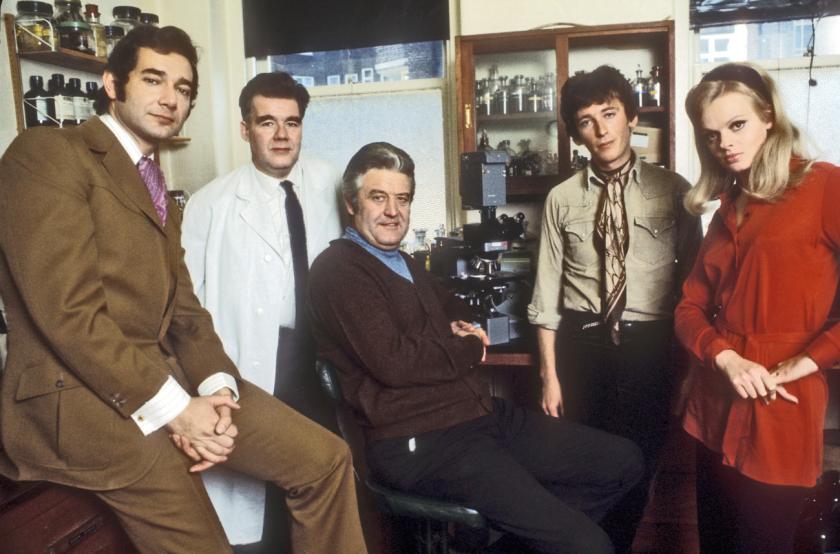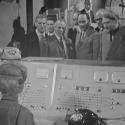When it aired on BBC One at the dawn of the Seventies, Doomwatch became one of the marvels of the broadcasting age, sometimes pulling audiences of over 13 million. Thanks to the keen imagination of its creator, Dr Kit Pedler – a gifted scientist and environmental campaigner – it possessed an apparently clairvoyant ability to seize on cutting-edge scientific ideas and their potential for running dangerously amok.
Pedler teamed up with screenwriter Gerry Davis, with whom he'd previously created the Cybermen for Doctor Who, and between them they delivered a programme which struck a chord with audiences concerned about nuclear stand-off and ecological issues. If the "drama" element of the shows was prone to creakiness, John Paul became a household name as the irascible but incorruptible Dr Spencer Quist, head of the Doomwatch team, while the 20-something Robert Powell became a runaway heart-throb.
 This seven-DVD set bundles together every extant episode from Doomwatch's three series (the show's entire broadcast lifespan only stretched from February 1970 to August 1972), though the BBC wiped many episodes, as was its wont back in the day. In particular, most of the third series is no longer with us.
This seven-DVD set bundles together every extant episode from Doomwatch's three series (the show's entire broadcast lifespan only stretched from February 1970 to August 1972), though the BBC wiped many episodes, as was its wont back in the day. In particular, most of the third series is no longer with us.
Present and correct, though, are most of the show's best-remembered moments. The first-ever episode, "The Plastic Eaters", wondered what would happen if plastic-eating bacteria designed to consume waste material escaped into the wider world (hint: it begins with an air crash). "Tomorrow, The Rat" posited the existence of super-intelligent laboratory rats capable of defeating traps, creating social networks and even farming mice like cattle. However, they also became ferociously carnivorous. This episode gained special notoriety for the way it coincided with a real-world epidemic of "super-rats" in Shropshire.
The perils of secret weapons research was a perennial Doomwatch theme. In "Invasion", Grassington in the Yorkshire Dales swarmed with army vehicles and soldiers in biological suits to tell a chilling story of a germ warfare infestation. In "The Red Sky", a young Paul Eddington was the boss of a corporation developing a secret rocket-powered aircraft on the Kent coast. Quist and his team discovered that the new engine technology created a freakish and fatal vibration. Robert Powell bowed out in series one's final episode "Survival Code", blown up while trying to defuse a nuclear bomb from a crashed RAF aircraft (this episode has vanished but Powell describes it in the bundled documentary film, The Cult of Doomwatch).
Other zeitgeist-grabbing stories included "Project Sahara", where Quist deplored the creation of a vast government computer database exerting Big Brother-ish control over the population, and "Train and De-Train", which depicted the potential devastation of the natural environment by a ruthless multinational pesticide manufacturer. In "The Devil's Sweets", an unscrupulous tobacco company teamed up with a cartoonishly sleazy advertising man to create smoking addicts with the aid of drugged chocolates (Dr Kit Pedler, pictured below).
 However, Doomwatch was already flagging by series two. Though scientifically prescient, it was dramatically clunky, and looks comically primitive 45 years later. Even in the Seventies it earned brickbats for its portrayal of women, who were usually mini-skirted dolly-birds cast as secretaries and assistants (typified by Wendy Hall's Pat Hunnisett). One of the first lines spoken by Dr John Ridge, played by Simon Oates like a low-rent Roger Moore, was "I pinched her bum just before lunch". The introduction of Dr Fay Chantry in series two couldn't save it.
However, Doomwatch was already flagging by series two. Though scientifically prescient, it was dramatically clunky, and looks comically primitive 45 years later. Even in the Seventies it earned brickbats for its portrayal of women, who were usually mini-skirted dolly-birds cast as secretaries and assistants (typified by Wendy Hall's Pat Hunnisett). One of the first lines spoken by Dr John Ridge, played by Simon Oates like a low-rent Roger Moore, was "I pinched her bum just before lunch". The introduction of Dr Fay Chantry in series two couldn't save it.
This set includes the never-transmitted final episode from Series 3, "Sex and Violence". It became notorious for including scenes of real-life executions in Nigeria, but otherwise it's a stupendously boring parade of pontifical debates about sex, morality and media prurience, topped off with some self-righteous political grandstanding. Rigor mortis had long since set in.















Add comment